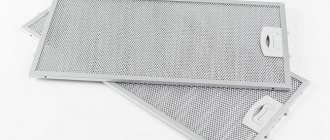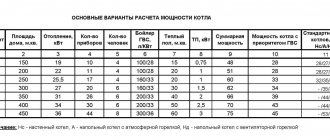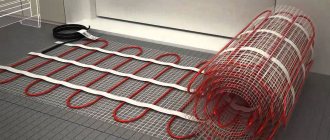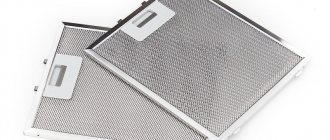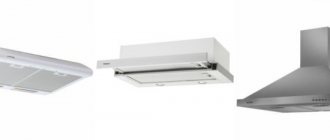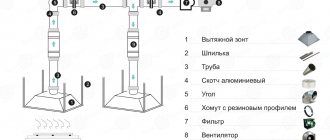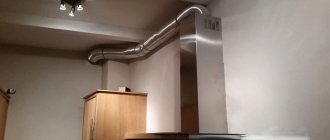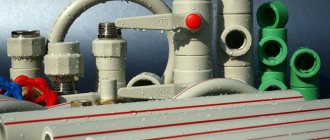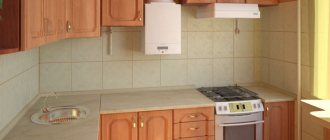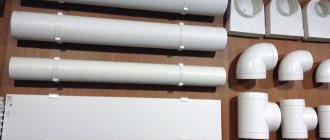When choosing a ventilation device, people often pay attention only to the design of the unit or the brand. But they forget about the most important parameter - the power of the kitchen hood (performance). Without the correct selection of this parameter, even the most beautiful unit from a well-known company will not be able to cope with its task of effectively purifying the air in the room. The performance indicator determines how much polluted air the device can pass through itself in a certain time; it is measured in m3/h.
Recommended power
The higher the power of the unit, the faster the air in the kitchen will be cleaned. The performance can be quickly calculated using the table below.
At a minimum, industrial devices for ventilation of kitchen premises have a capacity ranging from 200 to 300 cubic meters per hour. The cost of such models is low, and they cope with their task with difficulty. Low-power devices can only be installed in small rooms, provided that you do not cook very often. For frequent cooking, it is recommended to use a standard installation (power - about 600 cubic meters per hour), or with an increased pumping volume - about 1000 m3/h. Accordingly, the price of such devices is higher.
About the classic formula for calculating hood power
The classic formula: kitchen length × kitchen width × ceiling height × 10-12 (coefficient) = required hood performance.
Important! The formula given above is the basic instruction on how to calculate the performance of a kitchen hood, which you will find in many articles on the Internet - and it is certainly correct. However, this formula is a very general rule for choosing a hood with the desired performance indicators. Below we want to make important adjustments that will help you make a more accurate choice.
Important adjustments
- Thus, leaving no power reserve for emergency situations - the hood operates constantly in the most noisy mode.
- For electric models of hobs, the coefficient can be 15, for gas ones – 20 (after all, in addition to fumes from cooking, there are results of combustion of gas flows). So, for a kitchen 4 x 3 meters with a ceiling height of 2.7 meters, the calculation of the power of the kitchen hood will be the following performance indicators: 486 m3 h and 648 m3 h, respectively, for an electric and gas stove. For comfortable use, we recommend using the hood at medium speeds with a capacity reserve of 600-800 m3 per hour.
Power calculation
To calculate the performance of a hood, you first need to understand what functions the device should perform. According to the instructions, this device is supposed to purify or remove polluted air in the kitchen. According to sanitary standards, 12 air replacement cycles must take place within one hour. That is, he must change indoors 12 times in 1 hour. Now you know where the coefficient “12” comes from in formulas for calculating productivity.
The formula itself looks like this: Q=S*H*12, where:
- Q is the power of the unit, which is measured in m3/h;
- S – area of the room for which ventilation is needed;
- H – room height;
- 12 – coefficient indicating indoor air replacement cycles.
For example:
- room area - 12 m2;
- height – 2.7 m;
We substitute the values into the formula: Q=12*2.7*12=388.8 m3. Based on this calculation, the device will produce this volume only using maximum productivity. It will not withstand this mode for long and may fail.
To reduce the load, it is recommended to add about 15% to the calculated value.
This creates a small power reserve for the kitchen hood, making the appliance easier to operate. And you have the opportunity to turn on the maximum mode only during times of heavy smoke in the room, for example, on the eve of the holidays, when a large number of dishes are being prepared.
It should be noted that all these calculations for the volume of air exchange have average indicators, since various nuances are not taken into account:
- type of hob;
- hood type;
- room layout.
How to calculate the minimum required hood power for a kitchen
Power is the amount of electricity that is spent on lighting, fans and other functions of the device and is measured in kilowatts/hour (kW/h). The more working lamps and motors switching from mode to mode, the more electricity the hood will consume.
Power affects the calculation of hood efficiency. How much electricity the device will consume can be found out from the technical characteristics of the device specified in the instructions. The hood can have 1-2 lamps and the same number of motors, then the amount of power is multiplied by two. In this case, the motor runs faster, the higher the speed the consumer turns on. As a standard, the hood has 3 speeds, but there are also 4 and 5. And at each speed, kW/hours must be added to the initial value.
For example, if the hood has 1 motor with a power of 110 W, then at the first speed it consumes 0.11 kW/h, at the third – 0.33 kW/h. The same formula is applied to each light bulb, taking into account that they burn, evenly consuming the same amount of electricity.
When calculating the power of a kitchen hood, they take into account how much time is spent in the kitchen and how many burners will be used when preparing food.
The first speed is turned on constantly to keep the air in the kitchen clean. It is used when cooking 1 dish on the stove. If two burners or an oven are turned on at the same time, turn on the second, more productive mode. The third, fourth and fifth modes are launched if you need to quickly clean the air in the kitchen. For example, all the burners are turned on or something is burnt on the stove.
Attention! If you constantly turn on the device at maximum speed, the service life of the hood is reduced by a year.
Hob type
The type of stove determines how much pollutants can be released into the air during cooking. And updating it, accordingly, should occur more often or less often. The refresh rate must also be changed. The calculation of power for the kitchen when using an electric stove differs from the standard one, since no combustion products enter the air, except for fumes from the food being prepared. The coefficient for such slabs can be increased from 12 to 15, and the formula will look like this: Q=S*H*15.
Hood over electric stove
When you are going to use a gas hob, the coefficient should be increased to 20. This is done so that, in addition to fumes from the food being prepared, a large amount of harmful gas combustion products enters the atmosphere. In this case, the formula is written as: Q=S*H*20.
Hood over gas stove
How to calculate the power of exhaust equipment
The power ratings of a hood directly depend on its performance. The more air it can pump, the more powerful the fan is, which requires an electric motor to operate.
Recommendations for productivity depending on the size of the family and the amount of cooking
For equipment connected to ventilation ducts and operating only in exhaust mode, performance should be calculated based on the cross-section of the air ducts. It is almost impossible to do this without engineering knowledge and a housing design. And the calculation of hood power by area is only suitable for recirculation models. Unlike the first option, the size of the ventilation ducts does not affect their performance.
The simplest formula for calculating area
The classic calculation of the performance of a kitchen hood is to multiply the square footage of the kitchen, its height and a factor of 12. However, the resulting figure is very arbitrary. It does not take into account many factors.
This formula allows you to calculate parameters for ideal conditions:
- cooking on an electric stove;
- kitchen room with closed doors and windows;
- rectangular kitchen without an abundance of decorative frills.
If a gas stove is used for cooking, then the coefficient of 12 should be changed to 20 without hesitation. In this case, in addition to fumes, the hood will also have to remove gas combustion products from the kitchen. Plus, in any case, it’s worth adding 15–20% in reserve.
Calculation of the performance of exhaust equipment based on the cubic capacity of the kitchen
Another 25–30% of power must be added to the carbon filter. It creates additional resistance to the passage of air flow.
Important nuance! Calculations of performance and power for the hood should be made based on the area of the kitchen itself and the rooms adjacent to it, if they are not fenced off from the first.
If the door to the kitchen is constantly open or there is an arch instead, then the parameters of the exhaust equipment should be calculated based on the general square footage of the adjacent room. The same applies to corridors, as well as combined living rooms or halls. The absence of barriers increases the volume of processed air, as it constantly circulates between the kitchen and adjacent rooms.
Consideration of additional factors
The above performance calculation is based on exhaust hood with recirculation. If the equipment operates in exhaust mode, sending flow into ventilation, then its efficiency is greatly influenced by the throughput of the ventilation ducts. Of course, it is possible to increase the volume of air pumped through a narrow shaft by increasing engine power, but this leads to increased noise from the operating fan and overheating of the electric motor.
Approximate indicators of the required performance of a kitchen hood
In most private and apartment buildings, ventilation ducts in cross-section do not exceed 125 mm, which allows about 400 m3/h of air to be pumped through them. If you install a higher-capacity hood in the kitchen, it will be of little use. In addition, air ducts often have irregularities, narrowings and turns inside, which further reduces their capacity.
Important! The efficiency of a kitchen hood depends on the operating mode and method of its installation, as well as the cubic capacity of the room, the type of stove and the design features of the ventilation ducts.
If you follow a simplified calculation, then for a small kitchen area a low-power hood will be sufficient. However, formulas are formulas, and common sense never hurts. Smells from the stove fill a small room faster, and their concentration in this case is an order of magnitude higher than in a spacious kitchen. For a very small room where food is prepared, it is necessary to select equipment more powerful than the calculated indicators.
Hood type
The units differ in their operating mode, namely, where the air being passed through is discharged. There are 2 types of devices:
- ventilation;
- recirculating
The ventilation (flow) type of device involves connecting it to the ventilation duct in the house to remove exhaust gases outside. But before calculating the power, the channel capacity must be taken into account. If the house is old and the ventilation shaft is clogged, then even though you buy a powerful hood (according to calculations), it will not be able to remove air at full capacity. And for your neighbors in the riser, exhaust gases from your kitchen will be blown into the room. In such cases, you can make a separate exit for ventilation to the outside by making a hole in the wall.
The recirculation type of devices contains a filter system in its design and does not require connection to the ventilation shaft. In most cases, cleaning occurs in 2 stages. First, the first filter absorbs large particles: steam, grease and soot. The air then passes through a carbon filter, which removes all odors, and is returned to the room.
Filters may create some resistance when pumping, which also needs to be taken into account when calculating hood performance. The recommended increase in this value for such devices is approximately 30 – 40%.
Rules for choosing a hood for the kitchen
Built-in hood of a new model
When choosing an exhaust device, first of all, its dimensions are taken into account, determined by the dimensions of the kitchen stove or hob. If we take into account that their width is in the range of 45-90 cm, manufacturers offer models with a fixed number of parameters (50, 60, 90 and 120 cm). In addition, attention is paid to the installation height of the hood. According to current regulations, it is supposed to be hung at a distance of 0.75 meters from the surface of the source of pollution.
The performance of the purchased device must be sufficient to purify polluted air, taking into account the number of people living in the house. You should also ask what filters are built into the selected model.
It makes sense to purchase recirculation units with carbon filters for rooms where it is not possible to connect to existing ventilation.
Room layout
When calculating ventilation performance, the layout of the kitchen should be taken into account. If, for example, an arch is installed instead of a door, or you are used to not closing the door, then you should take into account the volume of the adjacent room when calculating.
If the kitchen is combined with a dining room or living room, then the requirements for calculating the performance of the device increase significantly due to the rapid spread of odors that need to be effectively removed.
Features of calculating the performance of a kitchen hood
People quite often mistakenly select a hood for their kitchen based on its power. Wattage refers to how much electricity (W) the equipment consumes. However, it is more correct to take into account the performance of the exhaust hood, because its indicator will determine how many cubic meters of air will be absorbed by the hood in one hour.
The formula for calculating productivity will be as follows: the kitchen area is multiplied by a factor of 12 (sanitary standard) and multiplied by the height of the ceilings. Also, you should take into account a certain power reserve, adding 20 percent to the result obtained. For example, a kitchen with an area of 15 sq. meters and a ceiling height of 3.5 meters. Productivity will be equal to 756 (15*3.5*12*1.2) cubic meters per hour.
The average figure recommended for normal operation of the hood is 500 cubic meters per hour
Here it is important to consider what type of exhaust system is installed. If it is a flow hood, the productivity will increase by 10%, if it is a recirculation hood, it will remain the same
It is better to purchase a hood for the kitchen with a reserve of performance. The reasoning behind this is that ventilation ducts may be dirty, kinked or leaking, leading to a drop in pressure and reduced performance.
Also, performance is affected by the number of operating fans that are built into the exhaust unit, as well as the operating modes that can be selected in the control panel. Typically, standard devices have a couple of fans and several power levels. In any mode, all fans are activated, and not individually.
This part of the article should include one more parameter that, according to people, affects performance - noise level. The harder the hood works, the louder the noise. However, today inventors have reached great heights in the design and modernization of exhaust systems, so new models are produced with minimal noise levels and high performance. You can always look at this indicator in the technical documentation or from a consultant in the store, because this factor directly influences the client’s choice and determines whether the hood suits the person’s request.
Noise level
Now that, using the recommendations described above, you have made calculations of the required hood power for your kitchen, you should think about the noise it will make. In a store, when choosing a device, you are unlikely to be able to assess the noise of the device due to the large size of the room or other noise in the sales area. The instructions that come with the unit will help you correctly evaluate this indicator.
The more powerful the device, the stronger the sound it produces.
In the instructions you should look at the sound parameters at maximum load and in normal mode of the device. If the noise level is between 30 and 45 decibels in standard mode, then the operation of the device will not cause you discomfort. Such hoods can be called practically silent. When operating at maximum, the sound should not exceed 55 decibels. If this figure is exceeded, then such a device may only be suitable for large rooms. Otherwise, the loud sound will cause discomfort.
By following the recommendations described above, you can choose the right hood power for your kitchen. And this, in turn, will help create a pleasant microclimate in the room and good health while cooking.
Choosing a kitchen hood: noise vs performance ↑
As power increases, the noise level of the exhaust system increases. Excessive noise will quickly tire a housewife; as a result, cooked food may turn out to be unsuitable for consumption.
A modern hood for a home kitchen makes 40–45 decibels of noise when operating.
Household hoods are equipped with asynchronous electric motors, which, unlike power units in vacuum cleaners or drills, are much quieter. However, when they are turned on at full power, the noise becomes noticeable. Only at low and medium speeds they do not create unpleasant sensations.
Advice! The optimal hood is a model with adjustable power and several operating modes.
There are no completely silent kitchen appliances. Manufacturers are doing everything possible to reduce its noise, but they are far from omnipotent. In this case, the noise intensity depends not only on the power of the electric motor and fan, but also on the cleanliness of filters and air ducts. Without regular maintenance, the hood will only bring headaches instead of comfort.
The most powerful kitchen hoods
Calculations of the optimal extraction power were given above. Now we present the top 5 most powerful models of 2021.
MAUNFELD URANIA 53
The UK company has developed one of the highest quality premium models that has many advantages over competitors' products. At the same time, it will not spoil the look of the kitchen, since it is completely built into it. Despite this, operating the device is very simple and does not cause any inconvenience.
Electronic control is organized using buttons and a display. In addition, you can switch the operating modes of the hood remotely, because it is equipped with a remote control.
As for power, in terms of this parameter Urania is considered one of the best. With a width of only 60 cm, it is capable of purifying up to 1250 cubic meters of air per hour.
It is also worth noting other advantages of the model: the presence of LED backlighting, a timer and four speed modes of operation. In addition, the new model received a perimeter suction system and an automatic ventilation function.
Types of kitchen hoods
The hood must be selected according to its power so that odors do not spread to other rooms.
The domestic market offers a wide range of ventilation products of various classes. It takes into account the characteristics of the kitchen space and the design of the exhaust unit itself. Among the presented samples, the following designs are distinguished based on these characteristics:
- dome model;
- hidden in pieces of furniture;
- telescopic;
- flat.
- T-shaped (island) or box-shaped.
The first type of exhaust structure is mounted directly above the stove, forming something like a dome that draws in air. It has significant dimensions and has an attractive appearance, reminiscent of an expensive fireplace. The hidden version of hoods refers to practical models that are built directly into kitchen furniture. Its owner can only see a small part of the product with the control panel placed outside.
The interior space of the cabinet in which such a device is mounted may be used for other purposes. This type of kitchen ventilation is available in relatively inexpensive models, suitable for users who want to save on the space occupied by equipment. Telescopic hoods are also mounted discreetly; To bring them into working position, it is enough to pull out the panel with the grease filters built into it.
Flat structures operate in the mode of natural circulation of air masses through the air ducts connected to them and are among the simplest devices of this class. Installation of such systems, as a rule, does not cause difficulties, since they do not need to be connected to an existing ventilation system. They are suspended directly above the stove parallel to the wall.
Island or T-shaped appliances are intended for large kitchen spaces or in the presence of ventilation systems combined with a bathroom. They are mounted on the walls or ceiling directly above the work plate and are characterized by a fairly high power rating. This category also includes box-shaped models that look like a pipe or steel box and are good at eliminating odors in the kitchen and bathroom.
Determining power in the classical way
Classic calculation of required power
Most often, when selecting the optimal power of a kitchen hood, the following formula is used: you need to determine the volume of the kitchen and multiply it by 10 or 12 - that is how many times per hour of using the stove, a high-quality hood completely replaces the entire air mixture from the kitchen.
However, this option for calculating the required power is very general, since it does not take into account any nuances of the kitchen and the conditions for using the hood. Therefore, this formula requires some adjustments.
First of all, it should be taken into account that the coefficient of 10-12 allows you to determine the power level of the equipment at the maximum speed of its operation. Therefore, by making a choice in this way, there is no reserve of power left in case of unforeseen situations. Thus, in case of such a choice, the hood will always have to operate at maximum speed, which will lead to unnecessary noise, and the service life of the device will be significantly reduced.
In addition, the calculation coefficient must be changed depending on the type of hob used. For example, for electric stoves a coefficient of 15 is required, and for gas stoves - generally 20, since gas combustion products are also added to various fumes.
You should also remember that when taking into account space, you should consider the area of the room limited by windows, walls and doors. So, if in the kitchen there is an arch instead of doors, then the area taken into account in the calculation is the kitchen itself and the room combined with it.
